Introduction
Due to the large number of features included in Hyper-V, starting with Hyper-V is not a simple task for beginners. Hyper-V administrators must know several basic features and tips to save time.
If you have any experience administering systems, you know that certain tips are fundamental, both for your job and for your mental health, making you an efficient and agile Hyper-V administrator.
First of all, improve your Hyper-V administration skills by learning the fundamentals of Windows Server. This may seem obvious, but having a working knowledge of the Windows Server OS is essential. After all, Hyper-V is a Windows Server component, but there’s more to it than that. There are several reasons why a strong foundation of Windows Server knowledge is essential. If administrators host VMs on Hyper-V, many of the VMs will most likely run Windows as the guest OS.
Table of Contents
- How to Create a Hyper-V Manager shortcut?
- How to Create a Shortcut of Hyper-V Virtual Machine?
- How to Connect to Hyper-V Virtual Machines without Opening Hyper-V Manager?
- How to Use Local Resources on Hyper-V Virtual Machine with VMConnect?
- Why is There no Reboot Option in Hyper-V?
- Conclusion
You also know that knowing those features/tips is a practically indispensable requirement even if these tips are basic.
So in this article, I will list the following features/tips and describe how to implement them in your environment:
- How to Create a Hyper-V Manager shortcut?
- How to Create a Shortcut of Hyper-V Virtual Machine?
- How to Connect to Hyper-V Virtual Machines without Opening Hyper-V Manager?
- How to Use Local Resources on Hyper-V Virtual Machine with VMConnect?
- Why is there no Reboot Option in Hyper-V?
Note: All the previous steps can be done on Windows 10 and Windows Server.
Furthermore, I would like to advise you on the following article: Top 11 Microsoft Hyper-V terminologies you need to know written by Brien Posey. This article explains the Hyper-V terminologies you need to know to correctly work with Hyper-V.
1. How to Create a Hyper-V Manager shortcut?

Creating a Hyper-V manager shortcut can be useful in some case, so in this section, I will explain how to create it. This tool is located in the following path:
Hyper-V Manager is available through Programs and Features as Hyper-V Management Tools on any Windows OS with Hyper-V included.
%windir%\System32\mmc.exe virtmgmt.msc
Note: Hyper-V Platform does not need to be enabled in order to manage remote hosts.
Step 1: Right click Desktop, select New and Shortcut:
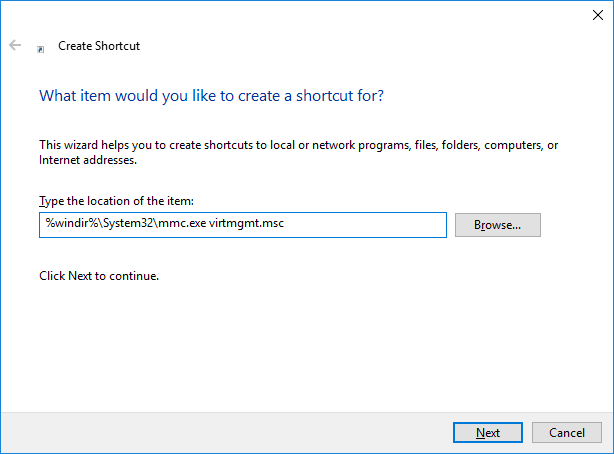
Step 2: Add a friendly name to this shortcut
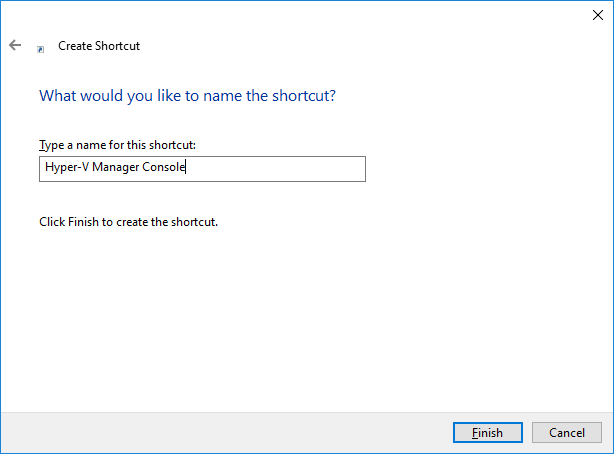
Step 3: You can change the icon if you want

Now, you can run the Hyper-V Manager console directly through this shortcut.
Many Sysadmins create their own toolbox based on the MMC console. So you can copy and paste this shortcut to your toolbox and you will save time when you connect on a server for the first time.
2. How to Create a Shortcut of Hyper-V Virtual Machine?
Here is probably one of my favorite tips when I have to manage Hyper-V infrastructure.
If you start working with Hyper-V, you probably know the Hyper-V manager console. The Hyper-V Manager console can be used to start and stop all your Virtual Machines. But sometimes, it is nice to star
When you want to connect to a VM, you must use the VMConnect tool. But, you can also use this tool to open a specific Virtual Machine directly. This tool is located in the following path:
C:\Windows\System32\vmconnect.exe
Step 1: Now, open the Hyper-V manager console and note the name of your Virtual Machine. In my case, the VM is called ‘Windows10’.
Step 2: Right click Desktop, select New and Shortcut:
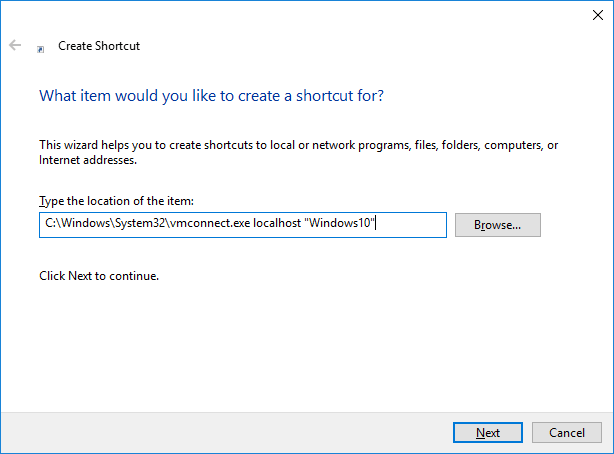
Step 3: Type the location including the Hyper-V hostname followed by the Virtual Machine name. In my case, I want to open the VM called ‘Windows10’, which is located on my local host. As you may imagine, you can specify the name of a remote Hyper-V host.
Step 4: Then you can give a friendly name to this shortcut:
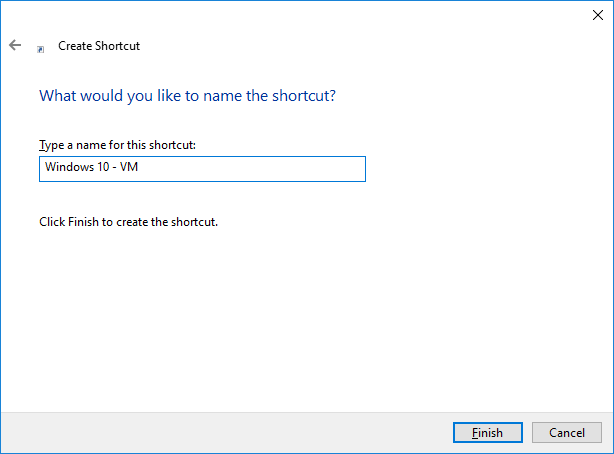
If you try to double-click the new shortcut:

You will get the following error:
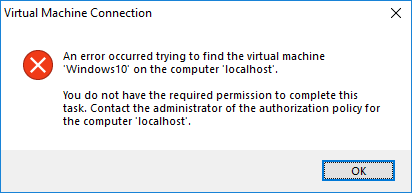
The standalone Virtual Machine Connection must be run as administrator.
Step 5: Right click your new shortcut and select Properties. Then select the Shortcut tab, and click Advanced:
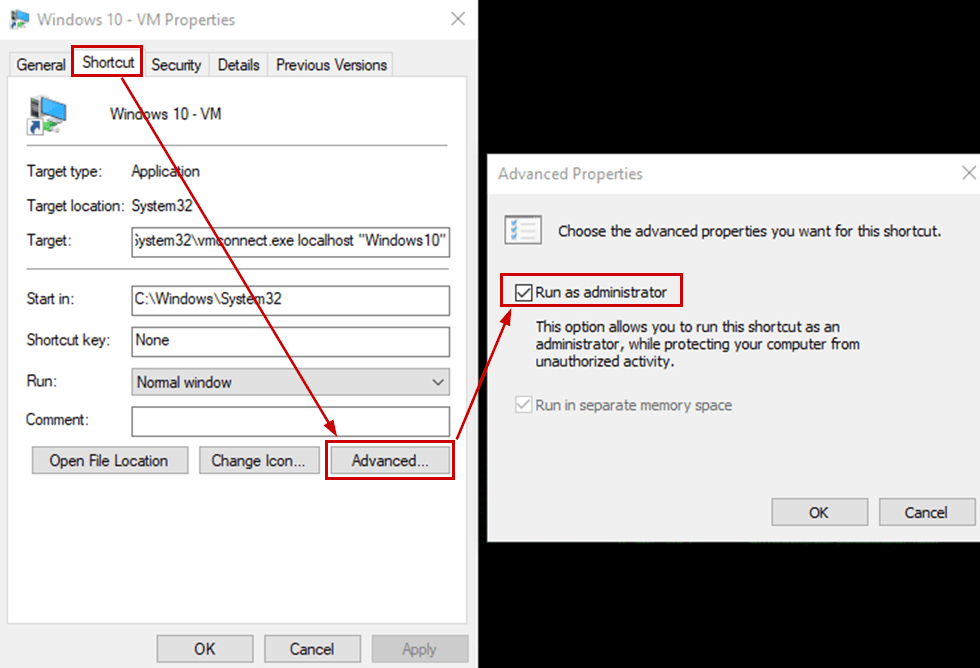
Step 6: Finally, confirm if it works by double-clicking the shortcut
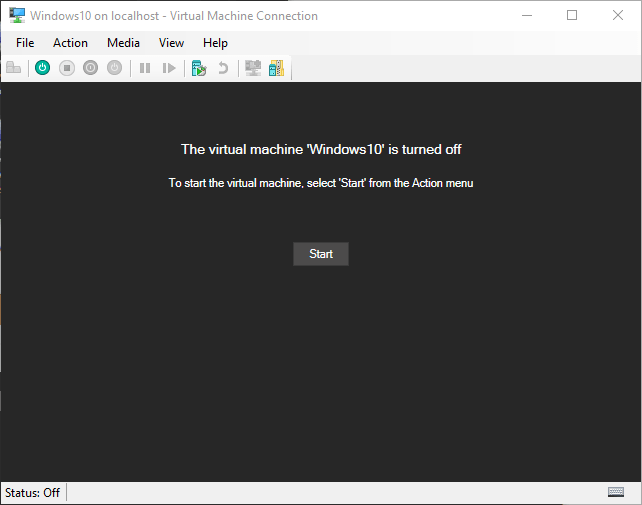
Note: you will get the UAC prompt every time you launch the Virtual Machine from this shortcut.
3. How to Connect to Hyper-V Virtual Machines without Opening Hyper-V Manager?
In this section, I will explain how to connect to a Virtual Machine hosted on a Hyper-V node without the need to open the Hyper-V Manager console.
This tip will help you to save time in your day-to-day task. This tip is interesting if you don’t want to install the Hyper-V management tools on your machine.
The tool used is Virtual Machine Connection (VMConnect) tool.
What is VMConnect?
VMConnect is a tool that you use to connect to a virtual machine so that you can install or interact with the guest operating system in a virtual machine. Some of the tasks that you can perform by using VMConnect include the following:
- Start and shut down a virtual machine
- Connect to a DVD image (.iso file) or a USB flash drive
- Create a checkpoint
- Modify the settings of a virtual machine
Step 1: Open the Windows Explorer, and navigate to the following path:
C:\Windows\System32\vmconnect.exe
Step 2: If you try to browse the available Virtual Machine located on your Hyper-V host, you will notice the following warning:
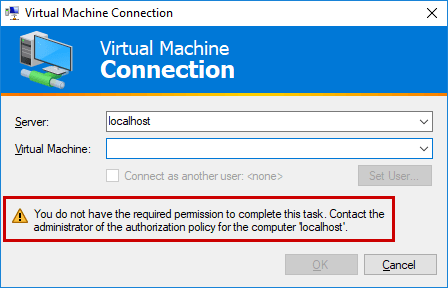
Notice the warning message. You must run the VMConnect executable as administrator to be able to list the Virtual Machines.
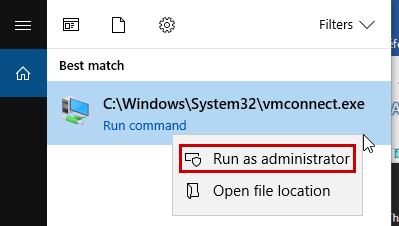
Step 3: Let’s confirm that the Virtual Machines are displayed:
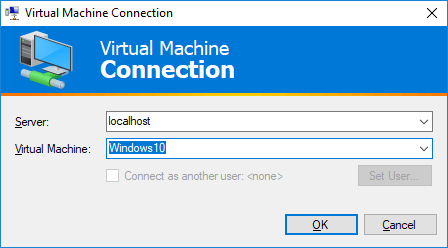
4. How to Use Local Resources on Hyper-V Virtual Machine with VMConnect?
Virtual Machine Connection (VMConnect) lets you use a computer’s local resources in a virtual machine, like a removable USB flash drive, local drive or a printer.
Step 1: First, start the Virtual Machine by clicking the start button:

Step 2: Then, you must wait a few seconds and the following popup will appear:
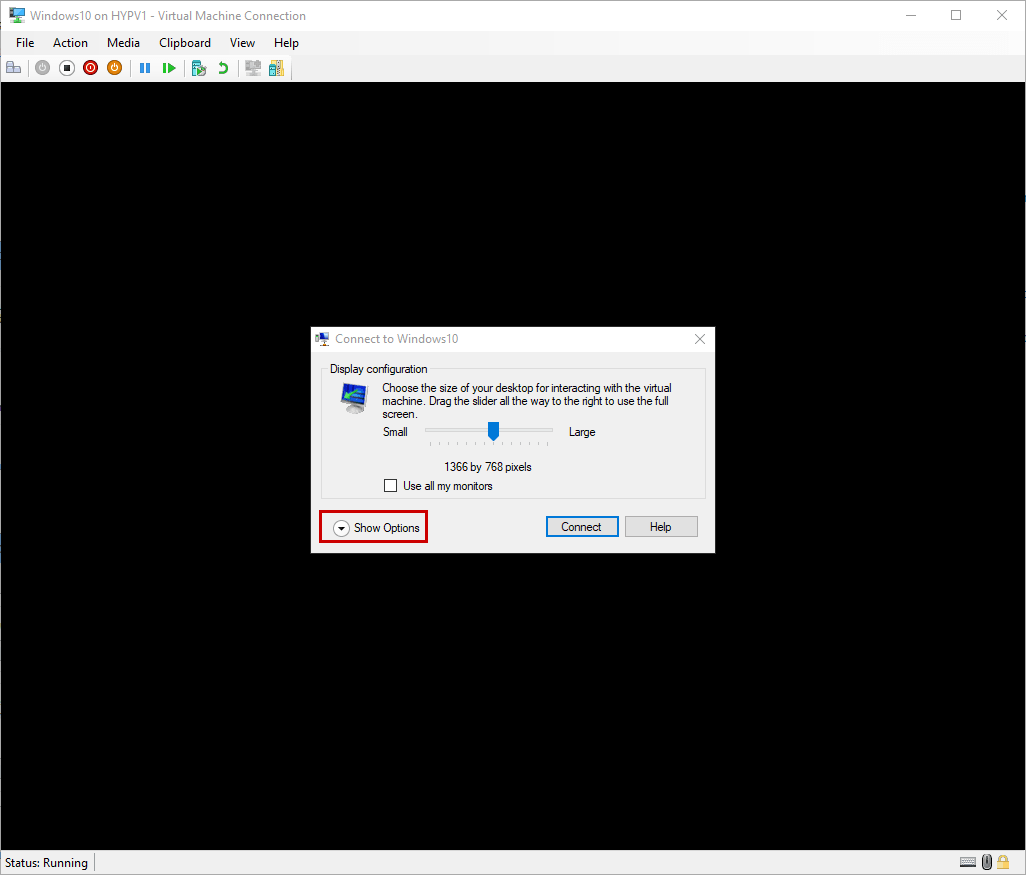
Click “Show Options” to expand the available options. The first tab allows you to configure the display settings:
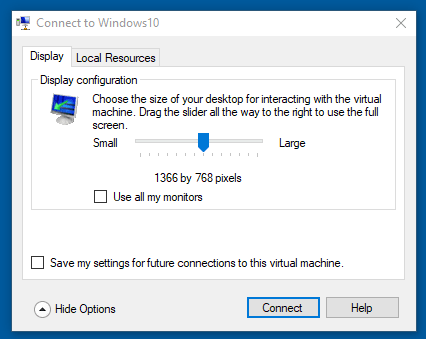
Step 3: Switch to the second tab called ‘Local Resources’ to select the drive that you want to use on the virtual machine.
You can also use the same clipboard between Virtual Machine and your local machine.

Requirements:
- The computer on which you use VMConnect must run Windows 10, Windows 8.1, Windows Server 2016, or Windows Server 2012 R2
- The Hyper-V host must have an Enhanced session mode policy and Enhanced session mode settings turned on
5. Why is There no Reboot Option in Hyper-V?
Starting a Virtual Machine can be performed easily by right-clicking on the VM and then selecting the ‘Start’ option as shown in the screen capture below:
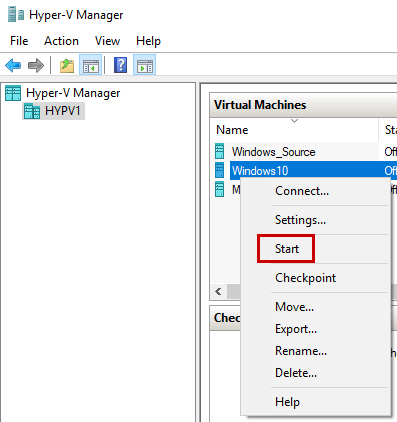
What about if you need to reboot the Virtual Machine?
Then, as you may probably notice, you do not have a ‘reboot’ action. When you right click Virtual Machines, you only have three options:
- Reset
- Turn Off
- Shut Down
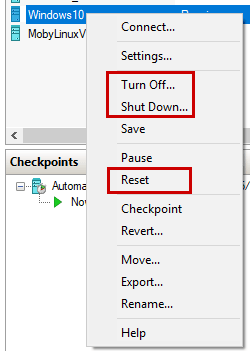
Step 1: First, you must reboot a Virtual Machine directly in the guest OS. It is the best practice.
Step 2: If you cannot access the Virtual Machine for any reasons, then select ‘Shutdown’ and ‘Start’ actions. The ‘Shut Down’ action sends a shutdown message to the guest OS and will save files in the Virtual Machine.
Step 3: To finish, use Reset only in emergencies when Virtual Machines are frozen. It is like a hard reset, when you hold down the power button on a physical machine.
So, yes, it is simple and fast but it is really not recommended.
Conclusion
To summarize, in this article, we discussed:
- How to Create a Hyper-V Manager shortcut?
- How to Create Shortcut of Hyper-V Virtual Machine?
- How to Connect to Hyper-V Virtual Machines without Opening Hyper-V Manager?
- How to Use Local Resources on Hyper-V Virtual Machine with VMConnect?
- Why is there no Reboot Option in Hyper-V?
With these features and tips, you can manage your Hyper-V environment easily and more efficiently. These tips are sometimes very basic, but it is important to know them to manage Hyper-V infrastructure.
BDRSuite is a one-stop solution for the Backup & DR needs of diverse IT environments that include VMware VMs, Hyper-V VMs, physical servers, and workstations – Windows, Linux, Mac, AWS EC2 instances, Microsoft 365 and Google Workspace.
BDRSuite for Hyper-V
BDRSuite for Hyper-V is a Secure, Scalable, and Reliable Backup & DR solution for Microsoft Hyper-V VMs. With BDRSuite for Hyper-V, you can back up all the virtual machines in your Hyper-V servers without installing an agent on each VM.
BDRsuite for Hyper-V – Feature Highlights
- Agentless VM Backup & Replication for Hyper-V Standalone Hosts and Cluster Servers
- Ensure RPO, RTO < 15 minutes
- Backup copy feature to store data both on-premise and cloud
- Application-aware backups with Log Truncation
- Resilient Change Tracking (RCT) based incremental backups
- Instant Boot VM with Live Migration
- Instant file & application-item level recovery
- Instantly restore individual files and folders without restoring the entire VMs
- Granularly restore the application items such as Microsoft Active Directory, SQL, Exchange, and SharePoint
- without restoring the complete image
- Supports Hyper-V Cluster, CSV, S2D an SMB share
- Automated Backup Verification to verify the recoverability of the backup
- Supports Cross-Hypervisor migration (V2V)
- VM replication to replicate your Hyper-V VMs from one host to another
- Centralized Monitoring tool and License Management portal
- Built-in AES 256-bit Encryption for backup data security
- Built-in Compression & Deduplication for efficient use of backup storage
- Offsite Replication for disaster recovery
These features allow extremely efficient and effective data protection for your Hyper-V environment.
With BDRSuite for Hyper-V, you can back up and protect Unlimited Hyper-V VMs. BDRSuite also offers BDRSuite for Hyper-V -Free edition. This free edition includes all product features for up to 10 VMs and limited features for the rest of the VMs.
Download BDRSuite – Free Edition and try it for yourself. Experience modern data protection for your environment.
To finish this article, please read the following article on Hyper-V configuration best practices written by Brandon Lee. This article will help you to configure your Hyper-V environment using the best practices.
You can also follow and share our Hyper-V series for Beginners below:
Beginners’ Guide for Microsoft Hyper-V: Overview of Hyper-V Part 1
Beginners’ Guide for Microsoft Hyper-V: How to Install Microsoft Hyper-V Using Server Manager – Part 2
Beginners’ Guide for Microsoft Hyper-V: How to Install Microsoft Hyper-V with PowerShell – Part 3
Beginners Guide for Microsoft Hyper-V: How to Install Microsoft Hyper-V in Windows Server Core – Part 4
Beginners Guide for Microsoft Hyper-V: Remote Management of Hyper-V – Part 5
Follow our Twitter and Facebook feeds for new releases, updates, insightful posts and more.



Leave A Comment